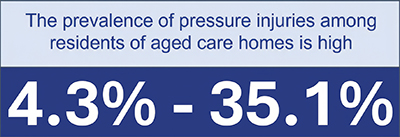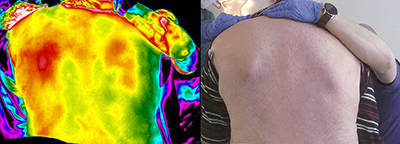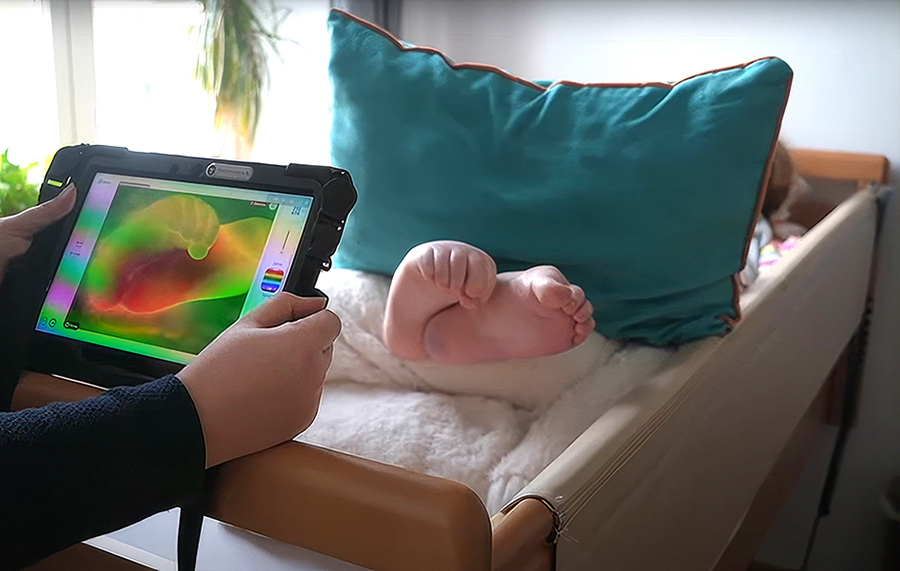Pressure injuries (PIs) are a common cause of harm in hospitals and care homes and can have a significant and negative impact on the lives of those affected, their families, and their carer’s. Yet PIs remains a large and largely unmet challenge in Care Homes.
 A meta-analysis of Care Home Pressure Injuries (CHPIs) in 20231, found the prevalence and incidence among older people living in nursing homes to be on average 11.6% across all PI stages, but was as high as 35.1% in some homes.
A meta-analysis of Care Home Pressure Injuries (CHPIs) in 20231, found the prevalence and incidence among older people living in nursing homes to be on average 11.6% across all PI stages, but was as high as 35.1% in some homes.
The study found that CHPI rates are comparable to hospital acquired pressure injury (HAPI) rates indicating the need for care homes to adopt targeted PI programmes.
A Danish study2 in care homes found that on average wound dressings are changed approximately three times a week, but almost one-quarter of wounds require daily dressing changes. PIs are therefore time consuming for care home staff and increase their workload.
So, can thermal imaging (or thermography) reduce HAPIs or CHPIs to zero?
Multiple studies3-5 have shown that medical thermography can objectively and accurately identify PIs in the form of thermal anomalies long before any visual symptoms. This allows for more effective monitoring and the ability to make better, faster, more informed treatment decisions in real time.

San Juan Medical Centre, in a 6-month trial with thermal imaging reduced HAPIs to zero6, while another hospital in Abilene Texas, achieved ZERO HAPI for over 10 continuous months7. Both have permanently integrated thermal imaging into daily care.
Another study8 goes as far to say that thermal imaging ‘should be an integral part of wound evaluations in the 21st century.’
This is NOT to say ALL PIs will be eliminated, but facilities that adopt thermal imaging should have significant reductions in PI prevalence and shorter days to healing.
A Thermidas thermal tablet makes daily screening for PIs a simple, efficient, and effective process. By providing quantitative data, thermography standardises skin assessment by removing subjectivity, reduces documentation errors, and streamlines electronic medical record workflows.

The learning curve for thermal imaging is short, and after initial support and training, a Thermidas Thermal Tablet will rapidly become a time-saving tool, transforming reactive care into a proactive, systematic approach to preventative care.
Care Homes can use thermal imaging records as evidence of exceptional care provision and leadership to improve Care Home ratings, and enhance their organisational reputation. This will positively affect resident satisfaction, referrals, and staff morale.
Thermography will also help care home operators meet The Enhanced Health in Care Homes Framework9, a key expectation of which is to minimise unplanned hospital admissions by proactive, personalised care.
In addition to PIs, Thermidas thermal tablets can be used for the screening and management of multiple morbidities including diabetic foot disorders, pain, MSD, pre-clinical infections, PAD, Charcot Foot, Osteomyelitis, DVTs, and thermal comfort, making it an incredibly versatile and cost-effective tool.
Finally, it is well documented that early signs of pressure injuries or DFUs are less easily identified in residents with darkly pigmented skin, but it should be noted, that the clinical utility of thermography is entirely unaffected by skin colour10.
For more information and a free demo, please contact Stephen Taylor at:
https://thermidas.fi
References
1) Sugathapala et al, 2023, Prevalence and incidence of pressure injuries among older people living in nursing homes_ A systematic review and meta-analysis
2) Jørgensen et al, 2013, Meeting the challenges of wound care in Danish home care
3) Koerner et al, 2019, Use of Thermal Imaging to Identify Deep-Tissue Pressure Injury on Admission Reduces Clinical and Financial Burdens of Hospital-Acquired Pressure Injuries
4) Cai et al 2021, Application of infrared thermography in the early warning of pressure injury_ A prospective observational study
5) Lin et al, 2021, Higher Periwound Temperature Associated with Wound Healing of Pressure Ulcers Detected by Infrared Thermography
6) McCall, 2022, ‘Beyond 4 Eyes in 4 Hours’ Implementing Long Wave Infrared Thermography
7) Holster, 2023, driving outcomes and improving documentation with LWIR in a LTA Care Hospital
8) Ramirez-GarciaLuna et al, 2022, Infrared Thermal Imaging: A New Paradigm for Wound Care
9) Enhanced Health in Care Homes: A guide for care homes (NHS, 2023)
10) Charlton et al, 2020, The effect of constitutive pigmentation on the measured emissivity of human skin

